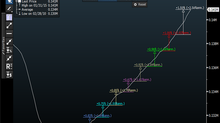Narratives Matter. So Does Data.
Through the years, I must have commented on this vast misconception about labor economics that simply will not go away.
In his January 11, 2024 column in the New York Times, Bret Stephens said the following:
"In 2017, the demographer Nicholas Eberstadt joined this pessimistic perception with comprehensive data in an influential essay for Commentary. He noted persistently sluggish economic growth and a plunging labor-force participation rate that had never recovered from the 2008 financial crisis."
"Far too little has changed since then. Labor-force participation remains essentially where it was in the last days of the Obama administration."
You will note Mr. Stephens even linked the chart in his article. Unfortunately, it's the wrong chart.

Once again, we need to note that LFPR counts from age 16 to death. And with the demographics we're dealing with now, that means this chart is worthless. Oddly enough, Mr. Eberstadt is a demographer.
(Note: further investigation reveals Mr. Eberstadt is in the employ of certain "think tanks," which means we can easily dispense with any of his "research" or opinions.
When using the Prime Age cohort, we find that the Labor Force Participation Rate is now at levels we haven't seen in over 20 years. The peak was hit in 2000 when it briefly touched 84.4%. We've been hovering over 83% throughout 2023, and that may be as good as it gets.

Why use Prime Age? Eberstadt and Stephens make the same error in using this statistic on two fronts. One, the younger age cohorts have a great deal of optionality as to when to enter the labor force. They can pursue higher education, join the military (this data only includes the civilian population) or have other options. On the other end of the scale, the older cohorts have some measure of control as to when to leave the workforce. (Latterly, COVID hastened that decision for them.) But using Prime Age removes those variables.
Here's LFPR for the Age 65+ cohort. You don't need a degree to see what the pandemic did to this age group.

Also, Roger E.A. Farmer reminds us: Participation is a choice. Unemployment is not.
Using the "all in" LFPR introduces a tremendous skew to the numbers. For reasons that have never been discovered, or at least explained to me, the age 16-19 Participation cohort rolled off a cliff starting in 2000, and it is THIS cohort that never bounced back. It went from a peak 52.4% in May of 2000 and plummeted to a low of 32.5 in February 2014. That is a shocking decline.

I've queried quite a few economists on line for an explanation for this, but never got an answer. In any case, it shows the error of counting in the manner Eberstadt and Stephens did.
Mr. Eberhardt's piece is worth reading, if only for his recitation of the economic sluggishness he complains about. The irony is lost when the very organization he is a member of advocated the very policies that gave it to us.
"Nicholas Eberstadt, a longtime COMMENTARY contributer, holds the Henry Wendt Chair in Political Economy at the American Enterprise Institute."
January 16, 2024













